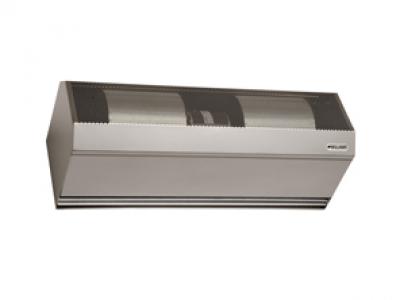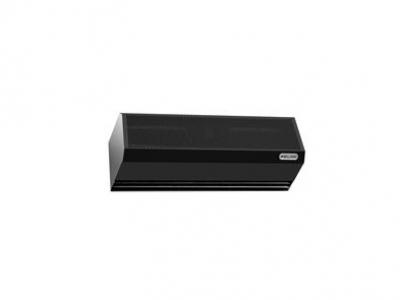An air curtain is a simple device used to separate two microclimate zones, most often the external and internal environment, by means of an air stream. Properly selected air curtains system creates a ventilation cover which, when opened, eg doors or gates, maintains air-conditioned air inside the room so that the cost of energy consumption can be significantly reduced. Depending on the object and the adopted curtain system, up to 70% of energy can be saved by various sources, which would otherwise escape outside through the open partitions. The purpose of the air curtain is usually to protect the entrance opening from the cold outside air when the door is constantly open or the opening frequency is high. In general, there is no need for an air curtain with closed doors. The air curtain also provides an air-conditioned room in the open in the summer before the cool outside air enters the building and infiltration, leading to an increase in the cooling load of the room. As a result of the movement of significant external air streams into the interior of the building, it is cooled down, which entails the need to reheat the premises during the heating period. This increases the demand for heating energy. In addition, outside air is also contaminated with outside air, which is particularly important for rooms with increased indoor air quality requirements, or particularly inconvenient when the building is in the vicinity of objects emitting air pollution. atmospheric. The basic function of entrance openings is to allow communication, but open doors can interfere with the climate and comfort inside the building. Often, this results in an increase in energy consumption and causes health problems in people inside these buildings. In such situations, air curtains are a great solution not to create physical barriers. These devices, placed above the open doors, prevent the negative effects of external air on the internal climate. Air curtains allow you to keep the comfort parameters in the building throughout the year. The open door allows people and objects to move freely, and the air curtain placed over them helps to separate the climatic conditions in two spaces and to reduce the costs of heating or cooling. Air curtains are most commonly used for: entry to commercial buildings, public buildings and hospitals, personnel and service doors, thermal separation of two rooms inside the building. Types of air curtains: due to the use and type of air flow, the curtains are divided into: air curtain with internal air, curtain without internal air heating, curtain combined with indoor air, curtain without external air heating, curtain for chilled rooms, curtain for long gates, curtain For technological processes. In this special case, they should be installed outside the cold store because the inside assembly would expose the unit to damage and to the moisture generated at the point of contact of cold air with warm external air in time. Door opening. For practical reasons, the most efficient device is a curtain that pours air from the bottom to the top of the door. However, it should be mentioned that due to the high air velocity, these devices are used in typically industrial gates, such as trucks, rail cars or forklifts. In most cases the curtains are mounted directly above the opening through which people pass and therefore, in addition to the pure technical aspect, consideration should be given to the comfort of being close to the equipment. Almost any type of curtain can be equipped with heating elements (electric heaters or water heat exchanger). Installing the curtain reduces the heat loss through the input openings by up to 90%.For the practical selection of the air curtain, the type of room for which the unit is to be chosen, the size of the entrance opening, the location of the curtain (top, bottom of the entrance opening), indoor and outdoor air temperature, wind speed and direction. The most important step is to determine the pressure of the "disposable" curtain, which will allow the air flow through the entrance door of the building to be inhibited.The pressure caused by the difference in density depends on the height of the entrance opening and on the temperature difference between indoor and outdoor air. The power supplied by the curtain can be defined as the pressure difference potential on both sides of the curtain that can still be eliminated by the curtain. The difference in pressure that the curtain must overcome is due to many factors such as the height of the building, the wind force and the location of the building relative to the wind direction, whether the leeward or windshield is involved, whether the building is mechanically ventilated and whether the pressure is generated over or underpressure. How intensive is the natural ventilation of the building. Hence, finding the correct amount of pressure difference that the air curtain should compensate for is laborious. It should be due to the balance of air flowing through the building ΣVi = 0 and from the pressure balance Δpi in the individual openings of the building (open) caused by the difference in density and wind pressure. The use of air curtains is especially recommended for doors and gates often open in all types of buildings, where it is possible to reduce the heat demand for building heating and cooling power. The most common curtains are the upper curtains mounted on the inside of a room equipped with a water heater or electric heater. Nevertheless, the use of a curtain without heating also results in savings of up to 30 ÷ 70% of the energy that would be necessary in the event of a drop out. It is not to be overlooked that this type of device can also fulfill the function of heating the room in the door area.


























